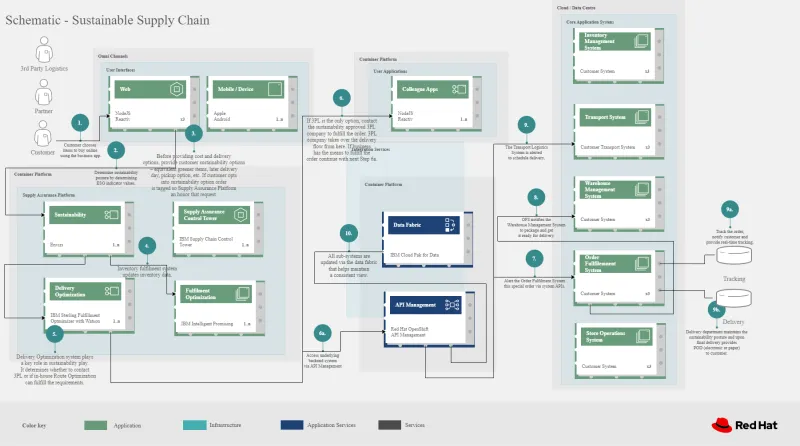A common definition of environmental sustainability is meeting the resource and services needs of current and future generations without compromising the health of the ecosystems that provide them. In addition to ongoing discussions around government regulation, investors and asset managers are increasingly demanding carbon disclosure from their portfolio companies. Investment in environmental funds is soaring—with some reports pegging it at over $40 trillion.
Even though specific actions taken by businesses are arguably still limited in overall impact, it’s nonetheless an increasingly prominent part of vendor, partner and customer discussions.
IT industry analysts also observe that sustainability projects can lead to a positive return on investment (ROI). According to Gartner, “Conventional wisdom around sustainability did not encourage business leaders to look at either ROI for sustainability endeavors or sustainability’s strategic importance in driving financial performance. However, this trend is changing as a better understanding of the link between business sustainability and business benefits has emerged.” (Gartner: Maverick Research: Sustainability Will Be the Guiding Principle for Digital Age Entrepreneurial Leadership, refreshed March 2022.)
Environmental sustainability in organizations takes many forms including optimizing use of electricity (such as optimized AI/ML workflows), instituting recycling and reuse programs (which fall under what’s sometimes called the "circular economy") and generally balancing the environmental costs associated with changes to processes and technologies with the benefits delivered.
Let’s take a broad look at some of the challenges and drivers around sustainability, and then consider a specific solution that optimizes the sustainability of how an organization fulfills orders and delivers goods to customers.
Challenges and opportunities
Becoming a truly sustainable business isn’t easy, but simply ignoring sustainability is no longer tenable. Four challenges are:
- Upfront costs to becoming a sustainable business
- Difficulty in measuring and demonstrating that you are lowering greenhouse gas (GHG) emissions
- Customers may not be willing to pay a potential premium for sustainable products
- Creating a lower emissions business given it affects all business processes and departments
But there are also drivers that encourage businesses to become sustainable—not least of which is that it can be good for the bottom line. These include:
- Increasing the creation and use of sustainable products
- Eliminating wasteful processes that don’t deliver value to the business or customers
- Identifying and monitoring energy and emissions savings opportunities to accelerate decarbonization
- Enhancing the customer experience with eco-friendly packaging
- Improving brand awareness by being known as a sustainable business
- Meeting customer requirements for environmental sustainability and reporting—for example with green-energy delivery fleets
Solution overview
The diagram below provides a high-level overview of the sustainable supply chain solution including the core application systems, the foundational infrastructure built on Red Hat OpenShift, and the inventory optimization platform.

The sustainable supply chain depicted below shows the flow of a typical sustainability use case. While the customer is the main focus, partners or suppliers and third-party logistics (3PL) companies could be involved. At every point in the supply chain there is room for sustainability to be improved.
The business can determine its sustainability posture by determining the appropriate ESG indicator values. ESG metrics are indicators of a company's overall performance and risk profile across important environmental (E), social (S) and governance (G) criteria. ESG metrics can be based on ESG and sustainability reporting standards, ESG rating frameworks from investors or analysts, or regulations like the European Union's Corporate Sustainability Reporting Directive (CSRD).

A customer starts the process off by selecting items to buy online through a channel of their choosing. Before providing cost and delivery options, the business may provide the customer with sustainability options such as equivalent greener items, a later delivery day or batching with other orders, pickup options and so forth. If a customer opts for any of these, the order is tagged so the Supply Assurance Platform can honor that request. The Inventory Fulfillment System updates inventory data.
The Delivery Optimization System plays a key sustainability role. For example, it determines whether to contact 3PL (Third-party Logistics) or if in-house Route Optimization can fulfill the requirements. If 3PL is the only option, the sustainability-approved 3PL company is contacted to fulfill the order. The 3PL company takes over the delivery flow from there. If the business has the means to fulfill the order, the underlying backend system is accessed via API Management.
Otherwise, the Order Fulfillment System (OFS) is alerted of this special order via system APIs. OFS then notifies the Warehouse Management System to package and get the order ready for delivery and the Transport/Logistics System is alerted to schedule delivery. The order is tracked in real-time and the customer is notified. Upon final delivery, proof-of-delivery is provided to the customer and all subsystems are updated via the data fabric to help maintain a consistent view of the supply chain and inventory.
Action Guide
From a high-level perspective, there are several main steps your organization can take to drive innovation and move toward a sustainable digital supply chain. For specific steps on this approach, see The Action Guide details in Own your transformation survey of 1500 CSCOs across 24 industries. It covers actionable steps in several areas of automation, sustainability, as well as the modernization to hybrid cloud platforms.
Summary
Sustainability is no longer a buzzword; it has real world implications. We have seen how businesses are striving to balance the long-term imperative of wanting to protect the planet while preserving the bottom line. The sustainability thought process starts when an order is placed and continues through all facets of manufacturing, warehousing and packaging. It only ends with the successful delivery of the order to the customer—and can really extend beyond that with repair and recycling programs.
If you are interested in more solutions built with these and other products in Red Hat's portfolio visit the Portfolio Architecture website and the Sustainable Supply Chain Portfolio Architecture, in particular.
Supply Chain blog series
This blog is part of a Supply Chain blog series:
- Supply chain optimization imperative – Read the blog
- Supply chain optimization – See the blog and associated Portfolio Architecture
- Demand risk – See the blog and associated Portfolio Architecture
- Loss and waste management – See the blog and associated Portfolio Architecture
- Product timeliness – See the blog and associated Portfolio Architecture
- Perfect order – See the blog and associated Portfolio Architecture
- Intelligent order – See the blog and associated Portfolio Architecture
- Sustainable supply chain – this blog and associated Portfolio Architecture
About the authors
Bruce joined IBM as a Solutions Architect focusing on distribution and communication sectors in the industry market in 2021 in Client Engineering. Bruce has been a solutions architect since 2001. He led the initial cloud migrations to Microsoft Azure, managed research compute resources at Microsoft Research and built out Kubernetes implementations.
Ashok is an Executive Cloud Architect in IBM Consulting Services. As a member of the Architecture Guild, he focuses on distributed and edge computing. He’s passionate about sustainability in the IT industry. He enjoys being a mentor, author, speaker and blogger. His blogs can be found here.
Karl joined Red Hat in 2021 as a Chief Architect focused on the Distribution sector. Prior to Red Hat, Karl was with IBM for over twenty-five years and served as the Chief Architect for the Retail and Consumer Industry in addition to other assignments. He is also an IBM Master Inventor.
More like this
14 software architecture design patterns to know
Getting started with socat, a multipurpose relay tool for Linux
Technically Speaking | Platform engineering for AI agents
Technically Speaking | Driving healthcare discoveries with AI
Browse by channel
Automation
The latest on IT automation for tech, teams, and environments
Artificial intelligence
Updates on the platforms that free customers to run AI workloads anywhere
Open hybrid cloud
Explore how we build a more flexible future with hybrid cloud
Security
The latest on how we reduce risks across environments and technologies
Edge computing
Updates on the platforms that simplify operations at the edge
Infrastructure
The latest on the world’s leading enterprise Linux platform
Applications
Inside our solutions to the toughest application challenges
Virtualization
The future of enterprise virtualization for your workloads on-premise or across clouds


